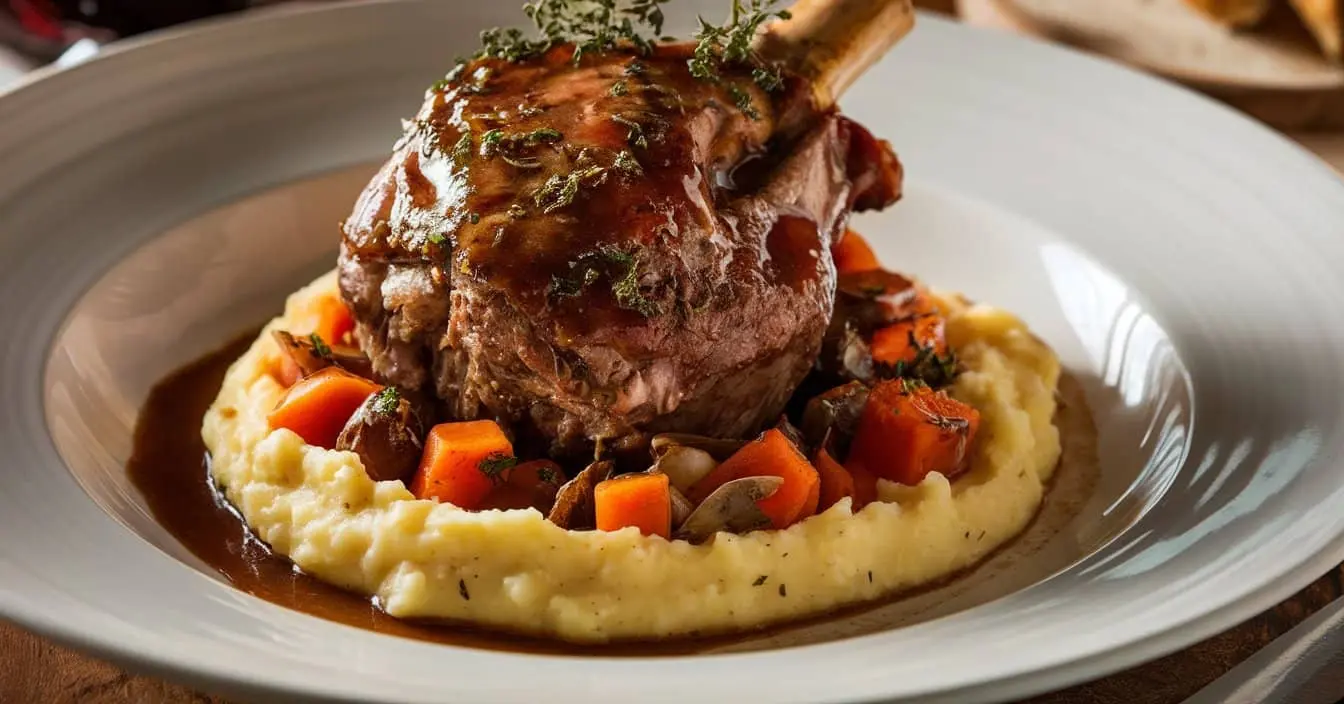Discover the best cooking methods for shank to transform this tough cut into a tender, flavorful delight. When considering the best cooking methods for shank, it’s crucial to understand the meat’s unique characteristics. The shank, rich in collagen, requires slow, moist heat to break down its connective tissue.
In this guide, we’ll explore the best cooking methods for shank, why low and slow cooking is essential, and how to bring out the best flavors in this underrated cut. Whether you’re preparing a comforting stew or a fall-off-the-bone braised shank, you’ll find everything you need here.
What is the Shank?
The shank is the lower portion of the leg in beef, lamb, or veal. Each of these types has unique uses in various cuisines:
- Beef shank: Often used in hearty stews and braises.
- Lamb shank: Common in Mediterranean and Middle Eastern dishes.
- Veal shank: The star of the classic Osso Buco dish.
The shank is rich in collagen and connective tissue, which means it needs long, slow cooking methods to break it down properly. For more information on how to cook beef shank to perfection, visit the Beef Shank Cooking Guide – Certified Angus Beef.
Why the Right Cooking Method Matters
The connective tissue in shank cuts contains collagen, which, when cooked at low temperatures for a long time, breaks down into gelatin. This is what gives the meat its tender, melt-in-your-mouth texture. Improper cooking can lead to a dry and chewy result, while slow cooking enhances the deep, meaty flavors. To avoid these pitfalls, it’s essential to choose the right cooking method. Therefore, understanding the best cooking methods for shank is extremely important.
For expert tips on cooking beef shank, check out the Mastering the Art of Cooking Beef Shank – One Stop Halal.
Best Cooking Methods for Shank
When it comes to cooking shank, the ideal methods are those that allow for slow cooking, breaking down the tough fibers and intensifying flavors. Here are the best cooking methods for shank:
Braising (Best Method)
- What is it? Braising is cooking in a small amount of liquid over low heat for an extended period.
- Why it works:
- Breaks down tough fibers into tender, flavorful meat.
- Creates a rich, flavorful sauce that complements the meat.
- When considering the best cooking methods for shank, braising is often the highest rated option.
- Best recipes using braising:
- Osso Buco (veal shank braised with tomato sauce and vegetables).
- Braised beef shank with tomato sauce.
Braising is the most effective method for transforming a tough shank into a tender, flavorful dish. If you’re looking for a slow-cooked beef shank recipe, try the How to Cook Beef Shank – The Prairie Homestead.
Stewing
- What is it? Stewing is similar to braising but with more liquid, like broth.
- Why it works:
- Fully submerges the shank, ensuring even cooking.
- Ideal for soups and stews, where the meat’s richness enhances the broth.
- Example dishes:
- Beef shank stew.
- Lamb shank curry.
Stewing allows the shank to simmer for hours, soaking up flavors and becoming incredibly tender.
You can also learn more about slow-cooked dishes in this Easy Delicious Sushi Bake.
Roasting
- What is it? Roasting works well for lamb shank, especially with a dry rub and slow roasting.
- Why it’s less ideal:
- Can dry out the meat if not basted regularly.
- Example dishes:
- Slow-roasted lamb shank with rosemary and garlic.
While roasting can be effective for lamb shank, it’s not as forgiving as braising or stewing.
Boiling
- What is it? Boiling is often used in Asian cooking to make broths.
- Why it works:
- Softens the shank over several hours.
- Creates a flavorful base for soups or stews.
- Example dishes:
- Chinese braised beef shank.
Boiling is a good option for infusing flavors into a broth or soup, but it’s not the best method for developing a rich sauce.
Tips for Cooking the Perfect Shank
To cook the perfect shank, follow these tips:
- Use a Dutch oven or slow cooker for even heat distribution.
- Sear the meat before cooking to enhance flavor and caramelization.
- Cook at low temperatures for at least 3-6 hours to break down the connective tissue.
- Add acidic ingredients (like tomatoes) to help break down the fibers.
By following these tips, you’ll create tender, flavorful shank dishes every time.
Common Mistakes to Avoid
Avoid these mistakes when cooking your shank:
- Cooking at high heat: This will result in tough, chewy meat.
- Skipping the searing step: This step locks in flavor and creates a rich crust.
- Not adding enough liquid: Insufficient liquid can cause the meat to dry out.
- Undercooking: Collagen needs time to break down properly, so don’t rush the process.
FAQs
What is the best way to tenderize beef shank?
- The best way is to use slow cooking methods like braising or stewing. Marinating in acidic ingredients such as vinegar can also help.
Can I grill or pan-fry beef shank?
- Grilling or pan-frying is not recommended for shank because of its tough texture. Slow cooking is necessary to break down the fibers.
How long does it take to cook a shank?
- Braising/Stewing: 3-6 hours.
- Boiling: 4-5 hours.
- Roasting: 2-3 hours.
What is the best seasoning for beef shank?
- Try garlic, rosemary, thyme, and black pepper to enhance the flavor of your shank.
Conclusion
In conclusion, braising is the best method for cooking shank, followed by stewing and roasting. Each method allows the tough fibers to break down, making the meat tender and flavorful. For best results, use a Dutch oven or slow cooker for even cooking. Experiment with different flavors and try making dishes like Osso Buco or beef shank stew to explore all the delicious possibilities this cut has to offer!
